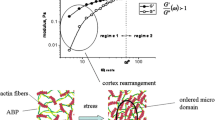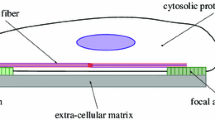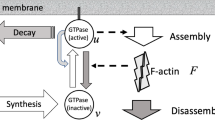Abstract
In this paper we develop and extend a previous model of cell deformations, initially proposed to describe the dynamical behaviour of round-shaped cells such as keratinocytes or leukocytes, in order to take into account cell pseudopodial dynamics with large amplitude membrane deformations such as those observed in fibroblasts. Beyond the simulation (from a quantitative, parametrized model) of the experimentally observed oscillatory cell deformations, a final goal of this work is to underline that a set of common assumptions regarding intracellular actin dynamics and associated cell membrane local motion allows us to describe a wide variety of cell morphologies and protrusive activity.
The model proposed describes cell membrane deformations as a consequence of the endogenous cortical actin dynamics where the driving force for large-amplitude cell protrusion is provided by the coupling between F-actin polymerization and contractility of the cortical actomyosin network. Cell membrane movements then result of two competing forces acting on the membrane, namely an intracellular hydrostatic protrusive force counterbalanced by a retraction force exerted by the actin filaments of the cell cortex. Protrusion and retraction forces are moreover modulated by an additional membrane curvature stress.
As a first approximation, we start by considering a heterogeneous but stationary distribution of actin along the cell periphery in order to evaluate the possible morphologies that an individual cell might adopt. Then non-stationary actin distributions are considered. The simulated dynamic behaviour of this cytomechanical model not only reproduces the small amplitude rotating waves of deformations of round-shaped cells such as keratinocytes [as proposed in the original model of Alt and Tranquillo (1995, J. Biol. Syst. 3, 905–916)] but is furthermore in very good agreement with the protrusive activity of cells such as fibroblasts, where large amplitude contracting/retracting pseudopods are more or less periodically extended in opposite directions. In addition, the biophysical and biochemical processes taken into account by the cytomechanical model are characterized by well-defined parameters which (for the majority) can be discussed with regard to experimental data obtained in various experimental situations.
Similar content being viewed by others
References
Abraham, V. C., V. Krishnamurthi, D. Lansing Taylor and F. Lanni (1999). The actin based nanomachine at the leading edge of migrating cells. Biophys. J. 77, 1721–1732.
Alenghat, F. J., B. Fabry, K. Y. Tsai, W. H. Goldmann and D. E. Ingber (2000). Analysis of cell mechanics in single vinculin-deficient cells using a magnetic tweezer. Biochem. Biophys. Res. Commun. 277, 93–99.
Alt, W. (1990). Mathematical models and analysing methods for the lamellipodial activity of leukocytes. NATO ASI (Adv. Sci. Inst.) Ser. H, Cell Biol. 42, 407–422.
Alt, W., O. Brosteanu, B. Hinz and W. H. Kaiser (1995). Patterns of spontaneous motility in videomicrographs of human epidermal keratinocytes. Biochem. Cell. Biol. 73, 441–459.
Alt, W. and R. T. Tranquillo (1995). Basic morphogenetic system modeling shape changes of migrating cells: how to explain fluctuating lamellipodial dynamics. J. Biol. Syst. 3, 905–916.
Bar-Ziv, R., E. Moses and P. Nelson (1998). Dynamic excitations in membranes induced by optical tweezers. Biophys. J. 75, 294–320.
Bausch, A. R., W. Moller and E. Sackmann (1999). Measurement of local viscoelasticity and forces in living cells by magnetic tweezers. Biophys. J. 76, 573–579.
Bausch, A. R., F. Ziemann, A. A. Boulbitch, K. Jacobson and E. Sackmann (1998). Local measurements of viscoelastic parameters of adherent cell surfaces by magnetic bead microrheometry. Biophys. J. 75, 2038–2049.
Bereiter-Hahn, J. and H. Luers (1998). Subcellular tension fields and mechanical resistance of the lamella front related to the direction of locomotion. Cell. Biochem. Biophys. 29, 243–262.
Borisy, G. G. and T. M. Svitkina (2000). Actin machinery: pushing the envelope. Curr. Opin. Cell. Biol. 12, 104–112.
Burton, K., J. H. Park and D. Lansing Taylor (1999). Keratocytes generate traction forces in two phases. Mol. Biol. Cell 10, 3745–3769.
Carlier, M. F. and D. Pantaloni (1997). Control of actin dynamics in cell motility. J. Mol. Biol. 269, 459–467.
Cevc, G. and D. Marsh (1987). Phospholipid Bilayers, New York: Wiley.
Condeelis, J. (1993). Life at the leading edge: the formation of cell protrusions. Annu. Rev. Cell. Biol. 9, 411–444.
Cramer, L. P., M. Siebert and T. J. Mitchison (1997). Identification of novel graded polarity actin filaments bundles in locomoting heart fibroblasts: implications for the generation of motile force. J. Cell. Biol. 136, 1287–1305.
Dembo, M., T. Oliver, A. Ishihara and K. Jacobson (1996). Imaging the traction forces exerted by locomoting cells with the elastic substratum method. Biophys. J. 70, 2008–2022.
Dembo, M. and Y. L. Wang (1999). Stresses at the cell-to-substrate interface during locomotion of fibroblasts. Biophys. J. 76, 2307–2316.
Eichinger, L., B. Koppel, A. A. Noegel, M. Schleicher, M. Schliwa, K. Weijer, W. Witke and P. A. Janmey (1996). Mechanical perturbation elicits a phenotypic difference between Dictyostelium wild-type cells and cytoskeletal mutants. Biophys. J. 70, 1054–1060.
Galbraith, C. G. and M. P. Sheetz (1999). Keratocytes pull with similar forces on their dorsal and ventral surfaces. J. Cell. Biol. 147, 1313–1323.
Guilford, W. H., R. C. Lantz and R. W. Gore (1995). Locomotive forces produced by single leukocytes in vivo and in vitro. Am. J. Physiol. 268, C1308–C1312.
Le Guyader, H. and C. Hyver (1997). Periodic activity of the cortical cytoskeleton of the lymphoblast: modelling by a reaction-diffusion system. C. R. Acad. Sci. Paris 320, 59–65.
Harris, A., D. Stopak and P. Wild (1980). Silicon rubber substrata: a new wrinkle in the study of cell locomotion. Science 208, 177–179.
Killich, T., P. J. Plath, H. Bultmann, L. Rensing and M. G. Vicker (1993). The locomotion shape and pseudopodial dynamics of unstimulated dictyostelium cells are not random. J. Cell. Sci. 106, 1005–1013.
Killich, T., P. J. Plath, H. Bultmann, L. Rensing and M. G. Vicker (1994). Cell movement and shape are non-random and determined by intracellular, oscillatory rotating waves in dictyostelium amoebae. Biosystems 33, 75–87.
Kim, K. S., J. Neu and G. Oster (1998). Curvature-mediated interactions between membrane proteins. Biophys. J. 75, 2274–2291.
Laurent, V. M., S. Henon, E. Planus, R. Fodil, M. Balland, D. Isabey and F. Gallet (2002). Assessment of mechanical properties of adherent cells by bead micromanipulation: comparison of magnetic twisting cytometry vs optical tweezers. J. Biomech. Eng. 124, 408–421.
Laurent, V. M., E. Planus, R. Fodil and D. Isabey (2003). Mechanical assessment by magnetocytometry of the cytosolic and cortical cytoskeletal compartments in adherent epithelial cells. Biorheology 40, 235–240.
Lee, J., A. Ishihara and K. Jacobson (1993). How do cells move along surfaces? Trends Cell. Biol. 3, 366–370.
Lewis, M. A. and J. D. Murray (1991). Analysis of stable two-dimensional patterns in contractile cytogel. J. Nonlinear Sci. 1, 289–311.
Lewis, M. A. and J. D. Murray (1992). Analysis of dynamic and stationary pattern formation in the cell cortex. J. Math. Biol. 31, 25–71.
Merkel, R., R. Simson, D. A. Simson, M. Hohenadl, A. Boulbitch, E. Wallraff and E. Sackmann (2000). A micromechanic study of cell polarity and plasma membrane cell body coupling in Dictyostelium. Biophys. J. 79, 707–719.
Mogilner, A. and G. Oster (1996). The physics of lamellipodial protrusion. Eur. Biophys. J. 25, 47–53.
Nielsen, C., M. Goulian and O. S. Andersen (1998). Energetics of inclusion-induced bilayer deformations. Biophys. J. 74, 1966–1983.
Oliver, T., M. Dembo and K. Jacobson (1995). Traction forces in locomoting cells. Cell. Motil. Cytoskeleton 31, 225–240.
Oliver, T., M. Dembo and K. Jacobson (1999). Separation of propulsive and adhesive traction stresses in locomoting keratocytes. J. Cell. Biol. 145, 589–604.
Oster, G. F. (1984). On the crawling of cells. J. Embryol. Exp. Morph. Supp. 83, 329–364.
Peskin, C. S., G. M. Odell and G. F. Oster (1993). Cellular motions and thermal fluctuations: the Brownian ratchet. Biophys. J. 65, 316–324.
Pourati, J., A. Maniotis, D. Spiegel, J. L. Schaffer, J. P. Butler, J. J. Fredberg, D. E. Ingber, D. Stamenovic and N. Wang (1998). Is cytoskeletal tension a major determinant of cell deformability in adherent endothelial cells? Am. J. Physiol. (Cell Physiol.) 274, C1283–C1289.
Radmacher, M., M. Fritz, C. M. Kacher, J. P. Cleveland and P. K. Hansma (1996). Measuring the viscoelastic properties of human platelets with the atomic force microscope. Biophys. J. 70, 556–567.
Ragsdale, G., K. J. Phelps and K. Luby-Phelps (1997). Viscoelastic response of fibroblasts to tension transmitted through adherents junctions. Biophys. J. 73, 2798–2808.
Raucher, D. and M. P. Sheetz (2000). Cell spreading and lamellipodial extension is regulated by membrane tension. J. Cell. Biol. 148, 127–136.
Rotsch, C., K. Jacobson and M. Radmacher (1999). Dimensional and mechanical dynamics of active and stable edges in motile fibroblasts investigated by using atomic force microscopy. Proc. Natl Acad. Sci. 96, 921–926.
Rotsch, C. and M. Radmacher (2000). Drug-induced changes of cytoskeletal structure and mechanics in fibroblasts: an atomic force microscopy study. Biophys. J. 78, 520–535.
Sheetz, M. P., D. Felsenfeld, C. G. Galbraith and D. Choquet (1999). Cell migration as a five-step cycle. Biochem. Soc. Symp. 65, 233–243.
Simson, R., E. Wallraff, J. Faix, J. Niewohner, G. Gerisch and E. Sackmann (1998). Membrane bending modulus and adhesion energy of wild-type and mutant cells in Dictyostelium lacking talin or cortexillins. Biophys. J. 74, 514–522.
Small, J. V., A. Rohlfs and M. Herzog (1993). Actin and cell movement, in Cell Behaviour: Adhesion and Motility, G. Jones, C. Wigley and R. Warn (Eds), The Society of Experimental Biology, pp. 57–71.
Soares, K. M. and C. C. Maghelly (1999). Linear instability analysis andmechanical interfacial tension. J. Theor. Biol. 196, 169–179.
Stephanou, A., X. Ronot and P. Tracqui (2003). Analysis of cell motility combining cytomechanical model simulations and an optical flow method, in Polymer and Cell Dynamics—Multiscale Modelling and Numerical Simulation, W. Alt, M. Chaplain, M. Griebel and J. Lenz (Eds), Basel: Birkhauser-Verlag, pp. 91–112.
Stephanou, A. and P. Tracqui (2002). Cytomechanics of cell deformations and migration: from models to experiments. C. R. Biol. 325, 295–308.
Stoker, J. J. (1969). Differential Geometry, Wiley-Interscience.
Strikverda, J. C. (1989). Finite difference schemes and partial differential equations, in Wadsworth and Brooks/Cole, Mathematics Series.
Sung, K. L., P. C. Dong, G. W. Scmidt-Schonbein, S. Chien and R. Skalak (1988). Leukocyte relaxation properties. Biophys. J. 54, 331–336.
Theriot, J. A. and T. J. Mitchison (1991). Actin microfilament dynamics in locomoting cells. Nature 352, 126–131.
Thoumine, O. and A. Ott (1997). Time scale dependent viscoelastic and contractile regimes in fibroblasts probed by microplate manipulation. J. Cell. Sci. 110, 2109–2116.
Valberg, P. A. and D. F. Albertini (1985). Cytoplasmic motions, rheology and structure probed by a novel magnetic particle method. J. Cell Biol. 101, 130–140.
Wang, N., J. P. Butler and D. E. Ingber (1993). Mechanotransduction across the cell surface and through the cytoskeleton. Science 260, 1124–1127.
Xu, J., A. Palmer and D. Wirtz (1998). Rheology and microrheology of semiflexible polymer solutions: actin filament networks. Macromolecules 31, 6486–6492.
Yamada, S., D. Wirtz and S. C. Kuo (2000). Mechanics of living cells measured by laser tracking microrheology. Biophys. J. 78, 1736–1747.
Yanai, M., J. P. Butler, T. Suzuki, A. Kanda, M. Kurachi, H. Tashiro and H. Sasaki (1999). Intracellular elasticity and viscosity in the body, leading and trailing regions of lomoting neutrophils. Am. J. Physiol. (Cell Physiol.) 277, C432–C440.
Zahalak, G. I., W. B. McConnaughey and E. L. Elson (1990). Determination of cellular mechanical properties by cell poking, with an application to leukocytes. J. Biomech. Eng. 112, 283–294.
Zaner, K. S. and P. A. Valberg (1989). Viscoelasticity of F-actin measured with magnetic microparticles. J. Cell Biol. 109, 2233–2243.
Zoller, J., K. Brandle and J. Bereiter-Hahn (1997). Cellular motility in vitro as revealed by scanning acoustic microscopy depends on cell-cell contacts. Cell Tissue Res. 290, 43–50.
Author information
Authors and Affiliations
Corresponding author
Rights and permissions
About this article
Cite this article
Stéphanou, A., Chaplain, M.A.J. & Tracqui, P. A mathematical model for the dynamics of large membrane deformations of isolated fibroblasts. Bull. Math. Biol. 66, 1119–1154 (2004). https://doi.org/10.1016/j.bulm.2003.11.004
Received:
Accepted:
Issue Date:
DOI: https://doi.org/10.1016/j.bulm.2003.11.004




